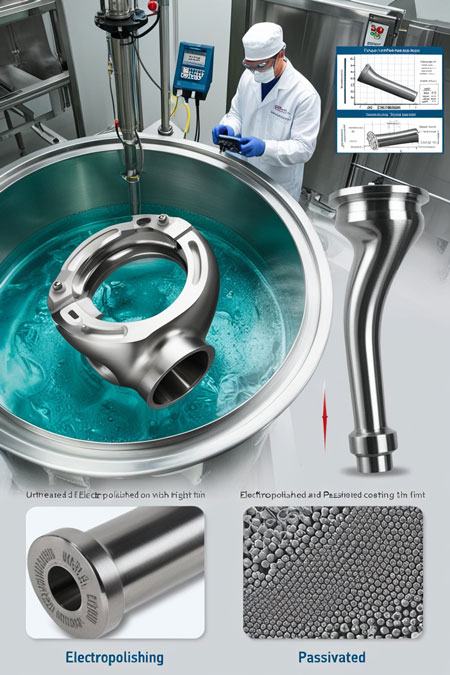 In the world of medical device manufacturing, the journey doesn’t end with precision machining. In fact, surface treatment and finishing are often the most critical stages in ensuring a component is safe, sterile, biocompatible, and ready for clinical use. Whether it’s a titanium bone plate, a stainless-steel surgical instrument, or a cobalt-chrome dental abutment, meeting medical-grade surface standards is essential for regulatory compliance and patient safety.
In the world of medical device manufacturing, the journey doesn’t end with precision machining. In fact, surface treatment and finishing are often the most critical stages in ensuring a component is safe, sterile, biocompatible, and ready for clinical use. Whether it’s a titanium bone plate, a stainless-steel surgical instrument, or a cobalt-chrome dental abutment, meeting medical-grade surface standards is essential for regulatory compliance and patient safety.
This is where processes like electropolishing, passivation, bead blasting, and specialized coatings come into play—each engineered to eliminate contaminants, improve corrosion resistance, and enhance surface smoothness.
The Need for Perfect Surfaces
Medical components come into direct contact with the human body, which means their surfaces must be free from burrs, micro-cracks, inclusions, and bio-reactive residues. Even microscopic imperfections can lead to complications such as infections, corrosion, or implant rejection.
Surfaces also need to meet stringent regulatory requirements defined by ISO 10993 (biocompatibility), ASTM F86 (passivation of surgical implants), and FDA Good Manufacturing Practices (GMP). Meeting these standards isn’t optional—it’s a fundamental requirement for entering global medical markets.
Key Surface Treatment Processes
- Electropolishing
Often referred to as “reverse plating,” electropolishing removes a thin layer of metal from the surface using an electrochemical process. This smooths out microscopic peaks and valleys, resulting in a mirror-like finish with improved corrosion resistance and reduced surface area for bacterial adhesion. Electropolishing is widely used for stainless steel surgical tools, orthopedic wires, and vascular implants. - Passivation
Primarily used for stainless steel, passivation involves treating the metal with an acid solution (usually nitric or citric) to remove free iron from the surface. This promotes the formation of a stable, chromium-rich oxide layer, enhancing corrosion resistance without altering the material dimensions. It’s an essential step in preparing components for long-term implantation or sterilization. - Bead Blasting and Mechanical Finishing
Glass bead blasting is often used to achieve a uniform matte surface on implants, particularly titanium parts. It can enhance osseointegration in orthopedic implants by creating controlled surface roughness. Mechanical polishing and buffing, on the other hand, are used to remove tool marks and prepare surfaces for subsequent treatments or coatings. - Specialized Coatings
Many implants benefit from bioactive or protective coatings, such as:
- Titanium Nitride (TiN) for improved wear resistance
- Hydroxyapatite (HA) for bone integration
- Parylene or ceramic coatings for electrical insulation and chemical resistance
These coatings not only improve functional performance but also contribute to patient-specific therapeutic outcomes.
Quality Assurance and Testing
Every treated surface must undergo rigorous inspection and validation. Techniques such as scanning electron microscopy (SEM), contact profilometry, and salt spray testing are commonly used to ensure the surface meets required parameters for roughness, cleanliness, and corrosion resistance.
Additionally, sterilization compatibility and cytotoxicity testing are mandatory before final approval and packaging.
Surface finishing is not just about aesthetics—it’s about performance, safety, and trust. As medical devices become more complex and regulations tighten, precision surface treatment has become a non-negotiable step in the manufacturing process. For job shops and OEMs alike, mastering these processes is essential to deliver components that heal without harm and meet the highest standards of global healthcare.


